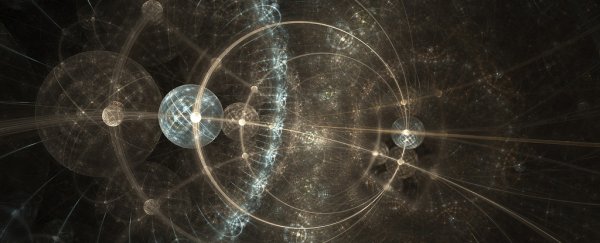An idea for an experiment that could unite the stubborn fields of quantum mechanics and general relativity has been given new life by two groups of physicists from the UK.
The fact that quantum theory doesn't play well with gravity is a massive stumbling block in physics, one that has long eluded some of the greatest minds in science.
Quantum mechanics is the modelling of discrete particles as probabilities that don't truly exist until we've nailed down a measurement. Not that quantum physics is vague – a century of testing has made it one of the most robust theories in science.
Alongside quantum mechanics is the general theory of relativity, which describes mass acting on a continuous, seamless fabric of space and time to give us gravity. General relativity is also one of the most reliable theories we have in science, allowing us to predict the movements of objects on a large scale with pin-point accuracy.
But in spite of their respective success at describing the Universe, the two theories hate each other's guts.
Making things harder is the fact that gravity is a seriously tricky force to study on an atomic scale.
"A formidable problem is the immense weakness of the gravitational interaction in comparison to other fundamental forces in nature," University of Central London (UCL) physicist Sougato Bose explained to Physics World.
"For example, even the electrostatic force between two electrons overtakes the gravitational force between two kilogram masses by several orders of magnitude."
To get some sort of hook on common ground, renowned American physicist Richard Feynman came up with an experimental design back in 1957.
He imagined a small mass that existed as a probability – or superposition – between two places. Put into a gravitational field, the mass should be linked to the quantum properties of gravity in a phenomenon called entanglement.
To see if the field was truly quantised in nature, Feynman suggested looking for signs of interference between the two possible locations before measuring its 'real' position.
If those two possible positions interfered with one another before they disentangled from the field, gravity would have a quantum nature that could be studied.
At least, that's the idea.
According to the authors of two new papers, the fact that a particle in a superposition could still interfere with itself – even inside a classical, continuous gravitational field – has left plenty of room for doubt.
But now they're proposing a slightly different approach to the experiment that could iron out some of the test's shortfalls, and just maybe solve one of the biggest problems in modern science.
A duo of physicists from the University of Oxford set out a proof that any two quantum systems could be entangled through a third system, but only if it too was quantised.
This conveniently opens the way for a pair of masses – each in superposition – to be coupled separately by being entangled with a quantum version of a gravitational field. If gravity isn't quantum, then there's no entanglement.
Based on this principle, a second team from UCL proposed details of an actual experiment that could use a hypothetical 'quantum gravity mediator' to entangle the spin of the two separate masses.
Such an experiment wouldn't be without its own practical challenges – the overwhelming push and pull of electromagnetic forces could itself be enough to mediate the entanglement, washing out any potential effects of quantum gravity.
But it's worth a shot, given how big the potential reward could be. Let's hope we don't have to wait another 60 years to see how Feynman's experiment pans out.
This research was published in Physical Review Letters here and here.
